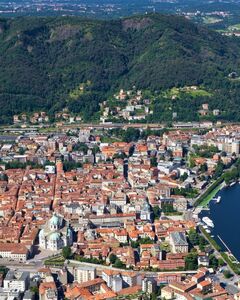
monuments near La Cà di Sala a Margno


Designed by architect Cesare Cattaneo and painter Mario Radice in 1935. It is a complex construction of circular elements whose harmonious composition consists of four spheres arranged on each other with alternate horizontal rings. Originally...
Located in Montepiatto, a village high above Torno with great hiking trails and equally fantastic views of the lake is the "Stone pendula", boulder resting on a pedestal. This boulder with its base has the appearance of a mushroom. It is thought...
Geological formations resembling mushrooms created when water running off the slopes was diverted by large boulders. The boulders imposing size and weight protected the underlying material from erosion and gave rise to the characteristic shape of a...
It’s a boulder of pyramidal shape that owes its curious name to a crescent engraved on one side, of natural origin, accompanied by the letters PLDB (Moon Stone of Bellagio) and the date 1782, which commemorates the end of a period of dispute between...
Monument to the fallen of World War I, designed in 1926 by architect Giuseppe Terragni and built between 1928 and 1931. It consists of a long stone staircase and river pebbles surrounded by cypress trees. The staircase consists of four flights and...
Monument to commemorate the victims of World War II and resistance movements. The monument is a project of Milan sculptor Gianni Colombo. It is located in a park by the lake. It combines stones from Nazi concentration camps and city of Hiroshima...
Daniel Libeskind created this dazzling 16.5 meter (54 feet) high stainless steel sculpture near Piazza Cavour, Como. The public monument, the first contemporary work ever to be installed in Como, is an homage to famed scientist Alexander Volta who...
The burial town where Alessandro Volta is buried was originally called Camnago, and took the name of Camnago Volta in 1863 in honour of this great scientist. The mausoleum, a temple of neoclassic style, was finished in 1831, decorated with statues...
Born in Como, Alessandro Giuseppe Antonio Anastasio Volta was an Italian physicist credited with the invention of the first electrical battery, the Voltaic pile, which he invented in 1799. With this invention Volta proved that electricity could be...
In the centre of the ancient village Palanzo, situated in the hills and part of the commune of Faggeto Lario, there is an enormous wine press of the 17th century. It is made to work during the annual feast called Sagra del Torchio in October. It was...
Immediately after the death of Alessandro Manzoni on May 22, 1873, the City Council of Lecco met and approved a monument to the writer that had given so much prestige to the city. The committee, headed by Antonio Stoppani, collected donations for...
Located in a churchyard, this statue represents a man in the act of throwing a large stone. The monument reminds locals of a battle in Libya in which alpinists of Brienno fought. The battalion Morbegno, all composed of soldiers from the lake area,...
Sculpture dedicated to disabled service people. Roughly translation on the plaque goes like this: "One hand is actively serving the country in defense of institutional values. The other hand is wounded in the line of duty." The monument is the most...
At the entrance to Laglio's cemetery is a curious pyramidal tomb containing the mortal remains of prestigious doctor Joseph Frank. Born in 1771 Frank was a student of physics and medicine in Pavia. He was a pupil of Alessandro Volta, of whom he...
In 1931, Giuseppe Terragni and his brother were asked by the fascists to design a monument for the victims of World War I. Their design was based on a sketch of the Italian futurist Antonio Sant'Elia, whose sketches showed modernity, dynamics and...
The Volta Lighthouse stands on a hill in San Maurizio, 150 metres above Brunate. From Brunate you can follow a walking path up to the lighthouse and it takes less than 30 minutes to walk there. You can pay an admission and climb to the top of the...
Here, a black cross marks the spot where Benito Mussolini was shot and killed (along with his lover Claretta Petacci) by partisans, marking the last stand of the Fascist dictator's rule over Italy. Actually, he wasn't really the ruler of Italy at...